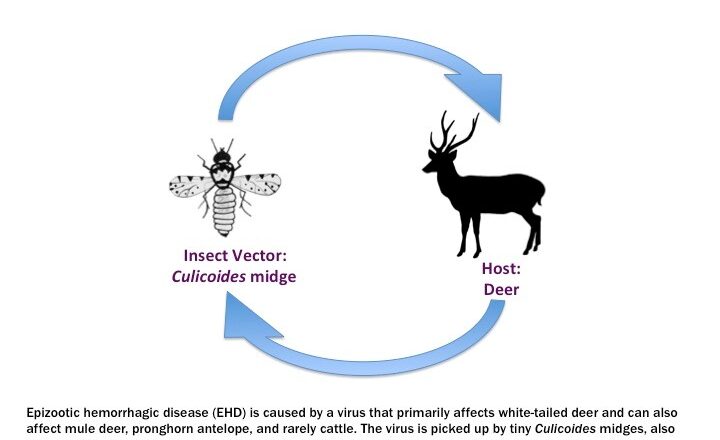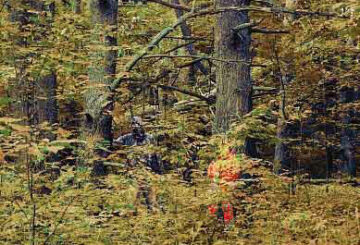From the NYS Department of Environmental Conservation
Image from Cornell University Wildlife Health Lab
| Additional Cases of Epizootic Hemorrhagic Disease in Deer in Suffolk and Rensselaer Counties Diseases Not Transmissible to Humans or Pets; New Yorkers Encouraged to Report Sick or Dead Deer The New York State Department of Environmental Conservation (DEC) today reported three deer in Southampton, Suffolk County, tested positive for bluetongue, which is closely related to the Epizootic Hemorrhagic Disease (EHD) virus and is transmitted in the same way. This is the first time the bluetongue (BT) virus was detected in New York deer. It was detected in several other mid-Atlantic coast states this year.DEC also reported that two white-tailed deer in the town of Schodack, Rensselaer County, found dead in late August, and one deer in Southampton, Suffolk County, confirmed positive for EHD. These are in addition to two deer in the town of Dover Plains, Dutchess County, that died from EHD in mid-August.EHD virus and BT virus are often fatal to deer. They are transmitted by biting midges (likely Culicoides sp.), small bugs often called “no-see-ums.” EHD and BT outbreaks are most common in late summer and early fall when midges are abundant. Diseases caused by the viruses are usually not spread directly from deer to deer, and humans cannot be infected by deer or bites from midges.EHD and BT cause similar symptoms in deer including fever, difficulty breathing, dehydration, swelling of the head neck and tongue, attraction to water, and rapid death. Frequently, infected deer will seek out water sources and many succumb in or near a water source. Once clinical signs of EHD or BT infection are apparent, deer usually die within 36 hours.There is no treatment or means to prevent EHD or BT in free-ranging deer. The dead deer do not serve as a source of infection for other animals. Both EHD and BT can infect cattle and sheep; cattle seldom exhibit signs of disease, but sheep can suffer severe disease and death from BT infection.The EHD virus was first confirmed in New York in 2007 with relatively small outbreaks in Albany, Rensselaer, and Niagara counties, and in Rockland County in 2011. In 2020, a large EHD outbreak occurred in the lower Hudson Valley, centered in Putnam and Orange counties, with reports from the public of approximately 1,500 dead deer. In 2021 the outbreak shifted and DEC received more than 2,000 reports of dead deer primarily in Ulster, Dutchess, Columbia, Oswego, and Jefferson counties.EHD and BT outbreaks do not have a significant long-term effect on deer populations, but deer mortality can be intense in small geographic areas. EHD is endemic in the southern states where there are annual outbreaks, so some southern deer have developed immunity. In the northeast, EHD outbreaks occur sporadically and deer in New York have little or no immunity to this virus. Consequently, most EHD-infected deer in New York are expected to die. In the north, the first hard frost kills the midges that transmit the disease, ending the EHD and BT outbreak. Sightings of sick or dying deer should be reported online (leaves DEC website) or to the nearest DEC Regional Office or Environmental Conservation Police Officer. More information about EHD and a link for public reporting of deer with EHD symptoms is at DEC’s website. DEC may collect samples from deer and analyze data from deer reports to determine the extent of the outbreak.For more information, visit Cornell University’s Wildlife Health Lab website (leaves DEC website).VIDEO: Link for an interview about BT with Kevin Hynes, Wildlife Health Program Leader with DEC’s Division of Fish and Wildlife. |





